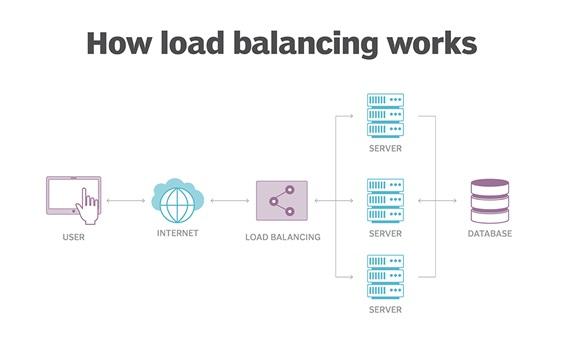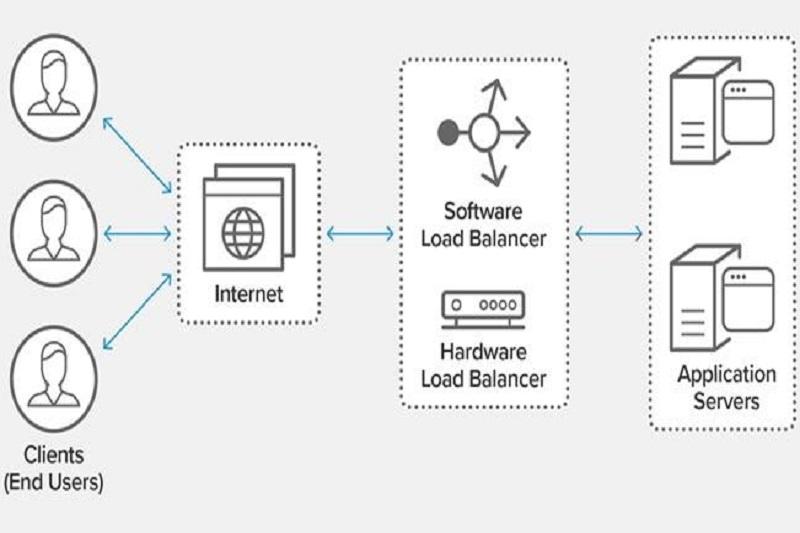What Does Load Balancing In Computer Networks Mean?
Load Balancing Is A Technique Used To Distribute Network Traffic Among A Collection Of Servers Called A Server Farm.
The above technique optimizes the reliability and capacity of the network and reduces the latency because the demand to access resources is evenly distributed among multiple servers and computing resources.
A load balancer uses a physical or virtual (software) device to determine in real-time which server in a pool can best respond to client requests while ensuring that heavy network traffic does not cause A server to stop moving.
In addition to maximizing network capacity and ensuring high performance, load balancing is an effective solution to overcome failure. So that if one of the servers fails, a load balancer immediately directs its workloads to a backup server, thus reducing the impact on end users.
Load balancing is usually a backup solution at layer 4 or 7 of the Open Systems Communication (OSI) model. A layer four load balancer distributes traffic based on transport layer data, such as IP addresses and TCP port numbers.
Layer 7 load balancers make routing decisions based on application-level attributes, including Hypertext Transfer Protocol (HTTP) header information and actual message content, such as URLs and cookies.
Typically, it is common to use a layer seven load balancing mechanism, but layer four load balancing is also popular, especially regarding edge deployment.
How does the load-balancing mechanism work?
The load balancer handles incoming user requests for information and other services. They sit between the servers responding to requests and the Internet. When a request is received, the load balancer determines which server in a pool is available and online and then routes the request to that server. A load balancer acts quickly when traffic loads become heavy and can dynamically add servers to the network to respond to traffic spikes. Additionally, load balancers can remove servers when demand is low.

Types of load balancers
Load balancing is a critical component of the high-availability infrastructure. Different load balancers can be used with other capabilities, functions, and storage complexity depending on a network’s needs.
A load balancer can be a physical appliance, a software solution, or a combination. Below are two types of load balancers:
Hardware load balancer:
- A hardware load balancer is a hardware device with proprietary firmware designed to handle large amounts of application traffic. These load balancers have built-in virtualization capabilities and allow multiple instances of a virtual load balancer to be used in a single device.
- Traditionally, vendors have loaded proprietary software onto proprietary hardware and sold them to users as standalone devices, usually used in pairs to overcome failure (failover) in the event of a system failure. Today, growing networks require organizations to purchase additional or more oversized equipment.
Software load balancer:
- A software load balancer runs on virtual machines (VM) or white box servers and is often used as an application delivery controller. Application delivery controllers provide additional features, including caching, compression, and traffic shaping. Virtual load balancing, prevalent in cloud environments, can provide high flexibility. For example, it enables users to automatically scale up or down as needed to respond to increases in traffic or decreases in network activity.
Hyper-Axis Load Balancer
Enterprises can use the cloud balancing mechanism as their underlying infrastructure to balance cloud computing environments.
Among cloud load balancing models, the following should be mentioned:
- Network Load Balancer: The fastest load balancer option, operating on layer 4 of the OSI model and using network layer information to transport network traffic.
- HTTP Secure Load Balancer: Allows network administrators to distribute traffic based on the information coming from the HTTP address. The above approach is based on layer seven capabilities and is one of the most flexible load-balancing options.
- Internal Load Balancer: Similar to Network Load Balancer, but can balance traffic distribution on internal infrastructure.
Load balancing algorithms
Load balancing algorithms determine which servers receive incoming requests from specific clients. There are two main types of load-balancing algorithms: static and dynamic.
1. Static load-balancing algorithms
In the IP hash-based approach, the target server examines the client’s request based on defined criteria, such as HTTP headers or IP address information. This method supports the durability of the settlement or stickiness. For this reason, it is a good option for applications that rely on user-specific stored state information, a typical example of which is the shopping cart in e-commerce.
The round-robin method goes through all the available servers sequentially and distributes the traffic among a list of servers rotating using the Domain Name System (DNS). A valid name server maintains a list of different “A” records and selects one in response to each DNS query.
The weighted round-robin approach allows administrators to assign different weights to each server. In this way, servers that can handle more traffic will receive slightly more traffic based on their weight. Weighting is configured in DNS records.
2. Dynamic load balancing algorithms
In the least-connections approach, servers with the fewest ongoing transactions are checked, and traffic is sent to servers with the most irregular open connections. This algorithm assumes that all relationships require approximately equal processing power.
The least-weighted connection method assumes that some servers can handle more traffic than others. Thus, it enables admins to assign different weights to each server.
The weighted response time approach uses the average response times of each server and combines them with the number of connections each server opens to find the best destination to send traffic to. This algorithm ensures faster service by forwarding traffic based on the quickest time the server can respond.
The resource-based algorithm distributes the load based on the availability of resources on each server at that moment. To benefit from the above method, a dedicated software called an agent must be run on each server to measure the availability of the central processing unit and memory before distributing the traffic.
Benefits of load balancing
Organizations that manage multiple servers can significantly benefit from load-balancing their network traffic. The main benefits of using a load balancer are as follows:
- Improved scalability: Load balancers can scale server infrastructure on demand, depending on network needs, without impacting services. For example, if a website begins to attract many visitors, it will experience a sudden increase in traffic. The website may crash if the server cannot handle this sudden traffic volume. A load balancer can spread excess traffic across multiple servers to prevent this from happening.
- Improved productivity: Due to the reduced traffic load on each server, the network traffic flows better, and the response time is improved. The above approach ultimately provides a better experience for site visitors.
- Reduced downtime: Companies that operate on a global scale and have servers located in multiple locations and time zones can benefit from a load-balancing mechanism, especially regarding server maintenance. For example, a company can shut down a server that needs care and redirect traffic to other available load balancers without interrupting service.
- Predictive analytics: Load balancing can detect failures early and help manage them without adversely affecting other resources. For example, software-based load balancers can predict traffic bottlenecks before they occur.
- Efficient failure management: In a failure, load balancers can automatically redirect traffic to available resources and backup options. For example, suppose a failure is detected in a network resource, such as an email server. In that case, load balancers can switch from healthy resources to responding to requests until the resources are restored.
- Improved security: The load balancer adds a layer of protection to the network without requiring other changes or resources. As more computing moves to the cloud, load balancers with robust security features protect these networks. In this case, the enterprise network becomes more assertive in dealing with distributed denial of service attacks.
Hardware vs. software load balancer
Hardware and software load balancers have specific use cases. The hardware load balancers manage exponential traffic loads, while software solutions are based on bandwidth calculation. The hardware load balancers require rack-and-stack equipment, while software load balancers are installed on standard x86 servers, virtual machines, or cloud instances.
The advantages and disadvantages of hardware and software load-balancing mechanisms are as follows:
Advantages
- They offer fast throughput because the software runs on specialized processors.
- These load balancers offer better security because they are managed only by the organization and not by a third party.
- They have a fixed cost.
Disadvantages
- Hardware load balancers require more staff and expertise to configure and plan.
- When multiple connections reach the specified limit, there is no scalability. When this happens, relationships are either rejected, dropped, or destroyed. In this case, buying and installing additional machines is the only option.
- They are more expensive because they cost more to buy and maintain. Having a hardware load balancer may require hiring consultants to manage it.
Software load balancer
Advantages
- They provide the flexibility to adapt to a network’s changing needs and requirements.
- By adding more software instances, they can scale beyond the initial capacity.
- Cloud computing offers various options, such as combined use with local resources. They provide cloud-based load balancing that is off-site and can run on a resilient network of servers. For example, a company can have a primary load balancer on-premises and a backup load balancer in the cloud.
Disadvantages
- Software load balancers may introduce latency when scaling beyond capacity. This usually happens when the balancing software is being configured.
- Software load balancers can increase costs when deployed since they don’t come with a fixed upfront cost.
